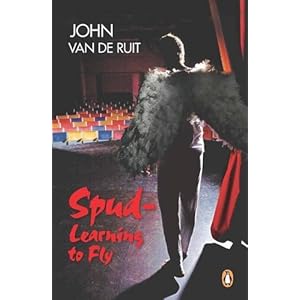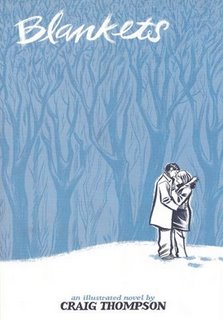The first time I heard about Shaun Tan was recently, when I was browsing through the graphic novels section at the bookstore. His new publication, The Arrival, was on display, and in the way that new books do, it lead me backwards to some of Tan’s previous publications. Lost and Found by Shaun Tan is an omnibus that contains The Red Tree, The Lost Thing, and The Rabbits. The book reads like a mix between a children’s book, a graphic novel, and a picture book.
The first story, The Red Tree, was my favorite, and it sort of hit me like a ton of bricks reading it for the first time. It’s a simple story, with only a handful of words on each page (the other two stories have much more narration), and the illustrations are done in a variety of styles of art, a few of which really reminded me of Dave McKean. The Red Tree describes an ordinary day, where a girl is waiting for a change to happen in her life. One illustration is of the girl drawing tallies on the back of giant snail shell, a snail that is in turn almost miniscule against the background, and it drips with the difficulty of waiting for time to pass to a place where a change can happen. Tan writes, “Sometimes you wait and wait and wait and wait and wait and wait and wait but nothing ever happens. Then all your troubles come at once. Wonderful things are passing you by. Terrible fates are inevitable.” The short story carries a weight with it, realistic and familiar, that is resolved in a simple, subtle, and beautiful way.
The second story, The Lost Thing, follows a narrator who begins, “So you want to hear a story?” which seems to express the weight of his experience that drives him to pass on his story. The story starts on a nondescript day, when the narrator finds “The Lost Thing,” with “a sad, lost sort of look. Nobody else seemed to notice it was there. Too busy doing beach stuff, I guess.” Tan’s illustrations in this story are beautiful and detailed, and his imagination devises a creature that seems to incorporate elements of a robot, an octopus, and a boiler, and is bright red in color. Unable to find its owner, the narrator follows instructions from another creature to find the place where lost things go. He leaves the thing in a place that is filled with others like it, but the narrator seems unsure that his Lost Thing really belongs there. Still, he leaves it there and goes on with his life, collecting bottle caps in a futuristic world where people seem indifferent to those lost things, the things that do not belong in their world. The Lost Thing was adapted into an animated film, and won an Oscar for Best Animated Short in 2011.
Finally, The Rabbits is written by John Marsden (the prolific Australian writer) and illustrated by Tan. It is a postcolonial tale, and, as Tan explains, “The Rabbits is a story of universe colliding: one culture driven by powerful technology that transcends nature (much like our own), and another whose spirit is embedded in an ancient ecology.” The words are supported and taken to a new level with Tan’s illustrations, and it rounds out this collection of three strong, powerful stories.










